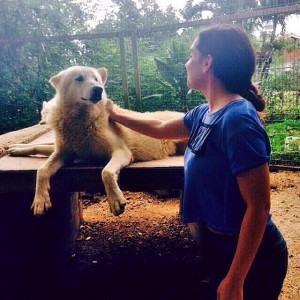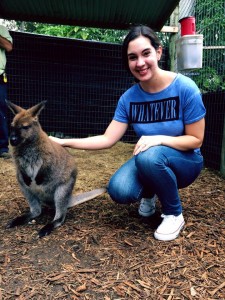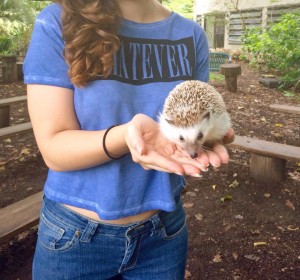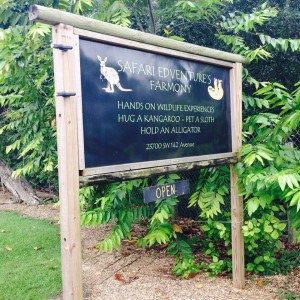Posted December 2, 2014
By ROXANA MAZA
HOMESTEAD, Fla. — Homestead may be known for its green pastures and organic markets, but it is also home to Safari Edventure’s Farmony, a non-profit, five-acre animal refuge home to more than 120 species, which offers visitors memorable interactions with wildlife.
Glenn Fried, director of the institution, started Safari Edventure 37 years ago and went on to migrate to its present Homestead location a few years ago.
With more than 200 animals, 90 percent of them have found their place at Safari Edventure whether by rescue, re-homing or rehabilitation.
The staff consists mostly of volunteers, who are educated and trained to handle the refuge’s wildlife.
Open to the public, Safari Edventure also hosts events, parties and school presentations, and partners with Solace Miami to provide animal-assisted therapy for individuals with certain psychological disorders, including anxiety and mood disorders.
Safari Edventure – spelled purposely with an ‘E’ – was ridden with raving reviews on TripAdvisor, ranking second out of sixth on its “zoos and aquariums” category for fun things to do in Miami.
I decided to drag a victim (read: my boyfriend) with me to check the animal refuge out.
Weather was a tricky factor when it came to visiting, but when called to confirm if they would be open, the staff on the other end of the line said, “we operate just like the post office – rain, snow, hail, we don’t stop working.”
With that reassurance, driving from West Kendall to Safari Edventure in Homestead was about a 30-minute ride. After parking and spraying an obnoxious amount of bug spray on any exposed limbs, I took notice of the big sign outside that included a few lines that read, “hug a kangaroo, pet a sloth, and hold an alligator.”
Both my human guinea pig and I were feeling the excitement.
One very enticing detail about Safari Edventure that may encourage a visit from those who prefer to watch animals on TV or film rather than in person is its price. Florida residents get a discount, so per adult it’s $12.
Compared to the $18 adult admission fee at Zoo Miami or the $43 adult admission fee for Miami Seaquarium – neither of which offer a Florida residents discount – this was a good deal.
Alex, a staff member, told us that our admission fee included encounters with the arctic wolves, the timber wolf, and the kangaroos.
On a rainy Wednesday afternoon, it became apparent after walking through the first, muddy trail that we were the only visitors that day. Besides us, there seemed to be only about three staff members on duty, two of which we saw sporadically.
Walking through the first trail, I noticed the refuge was full of avocado trees. Large, green avocados littered the ground where often times animals, namely two six-banded armadillos, were too busy feasting on to pay any attention to us humans.
Our first encounter was with a myna bird named Knock Knock.
Alex passed by on a different trail adjacent to ours and called out, “Knock Knock say hi!” and by those words alone, Knock Knock made some interesting sounds that resembled rhythmic drumming and tongue clicks.
Passing by the outdoor pens housing several aviary species such as peacocks, chickens and a variety of pigeons, we passed by a couple of Mandarin ducks native to Asia that apparently mate for life.
Similar to the peacock, the male exhibited beautiful and colorful feathers, ranging from orange, white, blue, brown, and red, while the female was a more subdued gray with blends of brown and white.
We saw three types of foxes – arctic, red and gray – that had one thing in common: they were busy snoozing the warm and humid afternoon away.
A family of brown lemurs native to Madagascar clung to the metal mesh of their cages, staring with wide, eager eyes at us. One lemur couldn’t sit still and kept walking back and forth.
Moving on, we passed by alligators, big and small, parrots of all kinds, stingrays, various fish, amphibians, reptiles and other wildlife.
In a wooden pen, we met Emma, a wild boar that was taken in young when her mother was shot and killed. Having been raised at Safari Edventure, Emma was sweet and gentle despite her large size. Wilbert, a one-and-a-half-year-old mini pot bellied pig, was her neighbor. I couldn’t remember being so close to a pig before or one that was so friendly.
I then look up to see a pack of three large, white wolves staring at us in intrigue. One was even wagging its tail. Did I look appetizing? Maybe they hadn’t fed them yet.
That’s when Alex came to greet us after leaving us to our self-guided mini adventure. He asked us how everything was going and if we wanted to go play with the wolves.
Play with wolves? Me? They seemed hungry and I did not have any plans to be a wolf snack any time soon. These were powerful animals, with a bite force two times stronger than a German shepherd, which was already the strongest of all dog breeds.
“You’re safer in there with those wolves than out here with people,” Alex said.
I wasn’t sure whether to laugh or not at the bold statement, but much, much sooner than I would’ve preferred, I found myself thrown to the wolves. Literally.
Three large predators, staring at you – one alpha male named Yukon and two females. They leapt from their five-foot resting platform in the middle of their pen and began to poke around and sniff, just like regular dogs, tails wagging.

Yukon, an arctic wolf and alpha of his three-wolf pack, appears docile and playful while writer Roxana Maza nervously petted his thick fur at a distance.
I prayed very hard that the fear I was failing to keep to a minimum did not incite some sort of instinctual reaction to attack.
Sensing my alarm and hesitation, Alex proceeded to stick his hand inside Yukon’s gaping jaws. My jaw was gaping, too.
“I can stick my whole hand in here and he won’t do anything. He loves being around people and he loves attention,” he said, while my courageous boyfriend played with the white alpha.
After taking some pictures and more petting, we left much to the pack’s dismay. Then we were introduced to Dakota, the seven-year-old timberwolf, which was large and gray, with piercing golden eyes.
Dakota was strong, and he would playfully jump toward you, but Alex would calm him down before he got a little too excited. It’s scary when a wolf is trying to playfully nip at your face.
When asked why Dakota was in a separate but neighboring cage next to the arctic pack, Alex told us that both males get along just fine – because Dakota is neutered – however, the females feel Dakota is a threat to their pack, considering he’s a male, so they become aggressive.
Next, we met Ruby and Timmy, a kangaroo and a wallaby. Feeding Ruby some honey graham cookies was fun.
Timmy, the wallaby from New Zealand, was probably about three feet tall. His fur was a chocolate brown and very soft. In that same area was a larger, male kangaroo, but because of his size and very poor eyesight, we couldn’t go in to meet him.

Timmy, the wallaby, was soft and slightly timid, but was social enough to pose for a picture with the writer.
To make sure he didn’t get lonely, they kept him with a young albino kangaroo, which was busy sleeping and eating hay simultaneously.
After leaving, Alex told us that although we missed the last wildlife presentation, he would gladly bring any of the animals used in the show out for us. That included a sloth, alligator, hedgehog, lemur, tarantula or python.
My boyfriend wanted to take a picture with the 14-foot Burmese python and the baby gator, so Alex went ahead and brought them out. I was not a fan of reptiles, so my two choices were the hedgehog and lemur.
“I don’t usually let people hold Leo,” Alex said while holding the hedgehog, “but since it’s just you two today, I’ll make an exception.”
Leonardo Da Pinchy – the hedgehog’s full name – was easy to handle, though Alex advised to keep a firm hand on Leo’s bottom, to keep him more balanced and steady.

Leonardo da Pinchy, a hedgehog, was very light and curiously sniffed at the writer’s hands that held him.
A popular exotic pet choice in recent times, Alex advises against it if the prospective owner is unable to dedicate enough time everyday in handling it.
Wild by nature, their defense mechanism is to spike themselves into a ball, and so if their owners are not constantly handling them, they will always spike themselves and never truly become domesticated pets.
Then Alex brought out Lenny, a baby Madagascar lemur that was severely attached to his yellow teddy bear. Even though Lenny was less than a foot tall, Alex told us he could jump 20 feet in the air.
Usually, the animal encounters at Safari Edventure aren’t one-on-one as, according to Alex, on weekends the park can host around 100 visitors a day. So when visitors are able to see the wolves or kangaroos, they let in a certain amount at a time so that everyone has a chance to interact with them.
There are also certain shows or talks on weekends visitors won’t see during the week, such as the reptiles, amphibians and arachnids presentation, so to get a fuller experience, it’s best to visit on a weekend.
Safari Edventure was an adventure in itself. It’s difficult to imagine playing with wolves or feeding kangaroos in South Florida, but this place made it possible.
The compassion the volunteers feel for the animals is what really seems to keep the refuge alive.
“We do it for the animals. We care so much about them, and helping people learn something new about them and interact with them, it’s worth all the effort,” said Alex.
If You Go
- Address: 23700 SW 142 Ave., Miami, Fla., 33170.
- Hours: Wednesdays to Sundays, from 10 a.m. to 5 p.m. No appointment needed during regular operating hours. Closed Mondays and Tuesdays.
- Admission fees: Florida residents: Adults $12, children 4-12 and seniors 60+ $9, children 3 & under free.
- Regular admission, non-Florida residents: Adults $15, children 4-12 and seniors 60+ $12, children 3 and under free.
- Active U.S. military families, (Active personnel, spouse and children entering with them): $2 off each.
- Teachers currently employed at any school in Miami-Dade County: $10.
- Credit cards accepted, but cash is preferred. No pets allowed.
- For more information, such as monthly events and both weekday and weekend presentations and talks, go to http://safariedventure.com or call 305-238-9453 or 305-255-9453.


